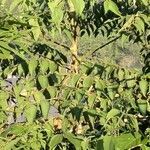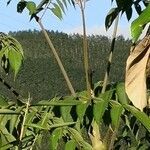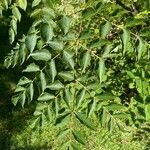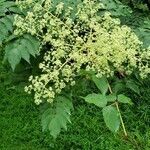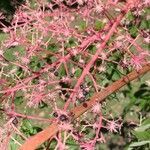Shrubs or small trees, 2-5(-8) m tall, andromonoecious. Branches armed with sparse prickles. Leaves 2(or 3)-pinnately compound, with a pair of accessory leaflets at each division of rachis; petiole to ca. 50 cm, glabrous or pubescent, prickly; petiolules 3-5 mm; leaflets 5-11(-13) per pinna, broadly ovate to elliptic-ovate or narrowly ovate, 5-12(-19) × 2.5-8 cm, membranous, papery, or subleathery, abaxially glabrous or light yellow or gray pubescent, sometimes or more densely pubescent on veins, or sometimes glabrescent, adaxially sparsely strigose, secondary veins 6-10 pairs, raised abaxially, conspicuous adaxially, base cordate to subcordate or rounded, margin serrulate, apex acuminate. Inflorescence a terminal panicle of umbels, densely yellow-brown or gray pubescent, unarmed; primary axis 1-5 cm; secondary axes 20-35 cm; ultimate axes with a terminal umbel of bisexual flowers and 1 to several lateral umbels of male flowers; bracts persistent, lanceolate to subulate, 2-5 mm, sometimes ciliate; umbels 6-15-flowered; pedicels 1-10 mm, densely pubescent. Ovary 5-carpellate; styles 5, free or united to middle. Fruit globose, ca. 3-4 mm in diam.; styles persistent. Fl. Jul-Sep, fr. Sep-Dec. 2n = 24*.
More
A shrub or small tree. It grows 6-12 m tall. It spreads 9 m wide. The stems are spiny and with few branches. It can produce suckers. It loses its leaves during the year. The stems have very large leaves at the top. The leaves are 1.2 m long and doubly divided. There are several pairs of branches from a prickly stalk. The are many leaflets which are curved and have teeth along the edge. They often have prickles underneath. The leaves turn red and yellow. There are about 80 leaflets. The flowers are tiny and cream in frothy clusters. These form at the tip of the shoot. The fruit are plum like and 6 mm across. The have 5 ribs and are black. They occur in large clusters.
Thin woodland and thickets on rich well moistened slopes, 900-2000 metres in N. Hupeh. Forests, forest margins, scrub fields, roadsides; at elevations from near sea level to 2,700 metres.
More
It is a temperate plant. In China it grows from sea level to 2,700 m above sea level. It suits hardiness zones 4-9. In Sichuan and Yunnan.
